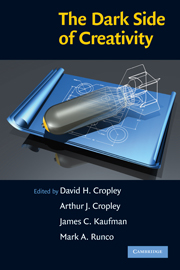Book contents
- Frontmatter
- Contents
- List of Contributors
- 1 The Dark Side of Creativity: What Is It?
- 2 Creativity Has No Dark Side
- 3 Positive Creativity and Negative Creativity (and Unintended Consequences)
- 4 Subjugating the Creative Mind: The Soviet Biological Weapons Program and the Role of the State
- 5 Imagining the Bomb: Robert Oppenheimer, Nuclear Weapons, and the Assimilation of Technological Innovation
- 6 The Innovation Dilemma: Some Risks of Creativity in Strategic Agency
- 7 Early Creativity as a Constraint on Future Achievement
- 8 Boundless Creativity
- 9 Reviewing the Art of Crime: What, If Anything, Do Criminals and Artists/Designers Have in Common?
- 10 Creativity in Confinement
- 11 Creativity and Crime: How Criminals Use Creativity to Succeed
- 12 So You Want to Become a Creative Genius? You Must Be Crazy!
- 13 Both Sides of the Coin? Personality, Deviance, and Creative Behavior
- 14 Neurosis: The Dark Side of Emotional Creativity
- 15 Dangling from a Tassel on the Fabric of Socially Constructed Reality: Reflections on the Creative Writing Process
- 16 Creativity in the Classroom: The Dark Side
- 17 The Dark Side of Creativity and How to Combat It
- 18 A Systems Engineering Approach to Counterterrorism
- 19 Malevolent Innovation: Opposing the Dark Side of Creativity
- 20 Summary – The Dark Side of Creativity: A Differentiated Model
- Index
- References
6 - The Innovation Dilemma: Some Risks of Creativity in Strategic Agency
Published online by Cambridge University Press: 05 June 2012
- Frontmatter
- Contents
- List of Contributors
- 1 The Dark Side of Creativity: What Is It?
- 2 Creativity Has No Dark Side
- 3 Positive Creativity and Negative Creativity (and Unintended Consequences)
- 4 Subjugating the Creative Mind: The Soviet Biological Weapons Program and the Role of the State
- 5 Imagining the Bomb: Robert Oppenheimer, Nuclear Weapons, and the Assimilation of Technological Innovation
- 6 The Innovation Dilemma: Some Risks of Creativity in Strategic Agency
- 7 Early Creativity as a Constraint on Future Achievement
- 8 Boundless Creativity
- 9 Reviewing the Art of Crime: What, If Anything, Do Criminals and Artists/Designers Have in Common?
- 10 Creativity in Confinement
- 11 Creativity and Crime: How Criminals Use Creativity to Succeed
- 12 So You Want to Become a Creative Genius? You Must Be Crazy!
- 13 Both Sides of the Coin? Personality, Deviance, and Creative Behavior
- 14 Neurosis: The Dark Side of Emotional Creativity
- 15 Dangling from a Tassel on the Fabric of Socially Constructed Reality: Reflections on the Creative Writing Process
- 16 Creativity in the Classroom: The Dark Side
- 17 The Dark Side of Creativity and How to Combat It
- 18 A Systems Engineering Approach to Counterterrorism
- 19 Malevolent Innovation: Opposing the Dark Side of Creativity
- 20 Summary – The Dark Side of Creativity: A Differentiated Model
- Index
- References
Summary
Ipse docet quid agam; fas est et ab hoste doceri [The enemy himself teaches me what to do; it is good to be taught by him].
OvidThe study of strategic interaction, in which players hope to influence the actions, beliefs, and feelings of others, has long been dominated by game theory. As a branch of mathematics, and a mostly normative one at that, game theory has had enthusiasts, but most social scientists have rejected or ignored it. Sociologists in particular have dismissed it without even knowing much about it. As a result, they have rejected the study of strategy altogether. Since sociology is my main discipline, since I see both insight and limitations to game theory, and since I believe that strategy is central to a great deal of social life, I have tried hard to develop a softer alternative to game theory (Jasper, 2004, 2006). This entails a fuller, more realistic recognition of emotions, cognition, and social context. And one of my hopes in doing this work has been to better understand the creativity of social action, especially the creativity found in social movements (Jasper, 1997).
In strategic settings, creativity has several characteristics that may not hold elsewhere. For one, it arises out of interaction as players act and react to one another; we must lay aside the popular image of the creative genius who first imagines new possibilities and only then presents or promulgates them.
- Type
- Chapter
- Information
- The Dark Side of Creativity , pp. 91 - 113Publisher: Cambridge University PressPrint publication year: 2010
References
- 10
- Cited by



